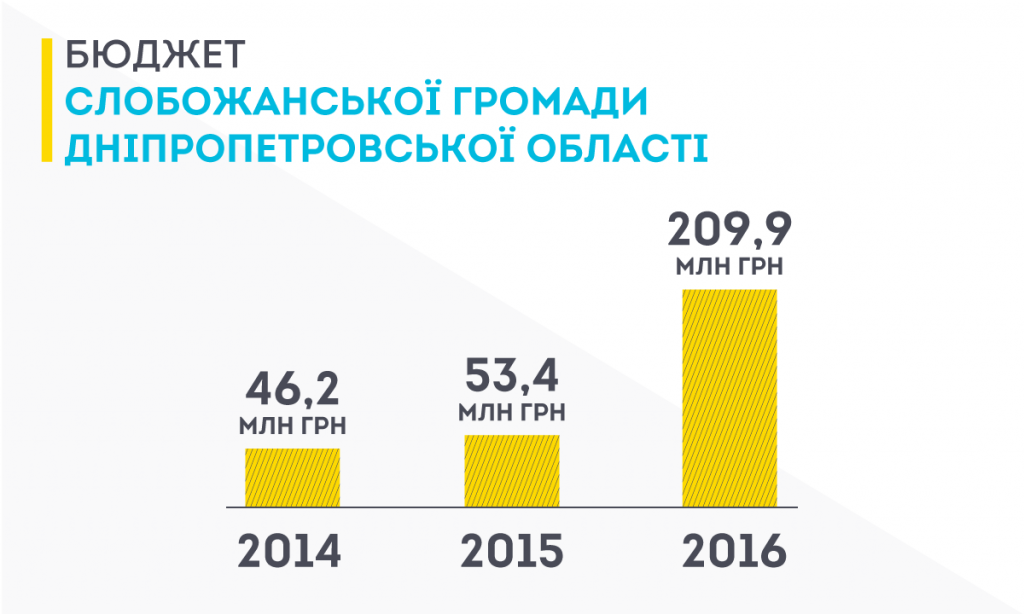A village from Slobozhanska community in Dnipropetrovsk shares their success story, points out the obvious advantages of decentralization such as new roads, renovations in schools and lays out plans for future.
Kyiv, October 26, 2016. A small, previously always subsidized, village of Stepove in Dnipropetrovsk region had to survive on a million hryvnias budget a year. A half of this amount was made of government subsidies. After Slobozhanska community was created, with the center in the village of Slobozhanske, the united community has earned more than UAH 200 million over 10 months in 2016. It was planned to spend UAH 25 million on the development of Stepove alone. This was stated by Yevgeniya Korinna, acting head of Stepove village, at a briefing held at Ukraine Crisis Media Center under UCMC initiative “Communities spokespersons”. “The citizens did not understand the reasons to unite. We were among the first, and no one knew what to expect. I just asked them to trust me, and only because of this people voted, and we decided to unite. Now people are happy with the changes taking place in the village,” said Ms. Korinna.
Who is the village head?
Despite the fact that now more responsibility passed to the head of the community council, Ms. Korinna states that the head does not have less work. “All the work I did before [as head of the village council – UCMC note], remained unchanged. The issue of schools, sanitation, water supply, or if light was cut off somewhere, or someone cannot share a border – everything remained within my competence,” she explained.
All official documents on the grounds
The fundamental point is that people do not need to go to the center for official documents, subsidies, permits, etc. “When we united, we had a clear agreement which we recorded in the memorandum: all services will be provided in the village, and no resident will have to go to the center for anything. The head has a seal. Any notarial acts, registration of subsidies – everything is done on the ground,” said Ms. Korinna.
Where does money come from and how is it spent?
According to Yevgeniya Korinna, the main source of local budget includes taxes, which now remain in the community instead of going to Kyiv. First of all, excise duty and income tax are concerned. “By the end of the year we plan to invest 25 million UAH in rural development, whereas previously only UAH 50-100 thousand remained. We have allocated UAH 7 million for school repair and now start merging gym with kindergarten, which will cost UAH 2 million. We also plan to repair the house of culture at UAH 5.5 million and to fully replace the old water drive system. We are repairing roads and street lighting as well as remodeling the center. All changes are hard to count, but they are very obvious,” informed the acting head of Stepove village.
What hinders the association process in other settlements?
First, according to the perspective plan Slobozhanska community should also have included other neighboring village councils: Chumakivska and Balivska. However, due to lack of information, they refused. “There is unawareness. We need to spread the story of our success and give tours of our village so that people see our achievements. Lack of information is hindering the process of decentralization,” believes Ms. Korinna.
Land is the most painful issue
According to Yevgeniya Korinna, current legislation impedes the decentralization objectives. “Legislation is lagging behind us. The urgent issue is the transfer of land to communities outside the settlements. We have some cases when the rent is 1 percent. We are not satisfied with this fact,” she stressed. The community supports the lifting of the moratorium on agricultural land sale. “We have some land that is not used; the administration is not interested, but for us it is important. The land should work, it should not be idle. It’s our additional income,” she explained.
Priorities
Among the priorities of Steppove are building bypass roads to let trucks detour to the village, repair of the hostel to provide social housing for the village doctors and teachers, lighting and repairs of the roads in the village.





